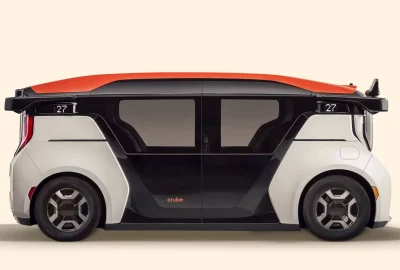General Motors (GM), Cruise, and Honda have unveiled ambitious plans to introduce a driverless ride-hailing service in Japan, potentially as early as 2026.
The companies have solidified their commitment through a memorandum of understanding, intending to establish a joint venture for this innovative project. However, the successful launch hinges on securing essential regulatory approvals, a process the partners aim to complete by the first half of 2024.
Cruise Origin
At the heart of this venture is the Cruise Origin electric shuttle van, a revolutionary self-driving vehicle co-developed by the three companies.
Unlike traditional automobiles, the Origin lacks a steering wheel, driver’s seat, pedals, or rearview mirror. Instead, it boasts a spacious cabin where up to six passengers can comfortably sit facing each other.
This looks like the futuristic self-driving taxi you’d imagine. Its sliding doors resemble those in subways, ensuring convenient entry and exit.
Automating Tokyo
“Honda has been a key partner with Cruise for several years, and we’re excited to offer safer and more accessible transportation to customers in Tokyo,” says Kyle Vogt, founder and CEO of Cruise. “All of our work scaling in dense urban US markets will position us well to address the huge opportunity for autonomous vehicles in Japan.”
According to GM, introducing this pioneering ride-hailing service holds promise in addressing the nation’s persistent driver shortage. It should provide a viable alternative for individuals unable to utilize Tokyo’s expansive train and subway networks.
While the project is still in its early stages, the companies have outlined a clear roadmap. Their initial objective is to deploy “dozens” of Cruise Origins in central Tokyo by 2026.
Following this phase, they plan to expand the fleet to 500 Origins. This expansion signifies a significant step forward – it will finally extend the service beyond the capital’s central areas.
Getting in an Origin
To access this innovative transportation solution, passengers will have the convenience of hailing a Cruise Origin through a dedicated app, streamlining the booking and payment process.
The partners will now work diligently to navigate regulatory landscapes in the new region. As of now, Cruise has only rolled out in major cities in the US – mainly California.
Cruise’s tumultuous path
Recently, Cruise vowed to implement safety upgrades for its fleet of robotaxis in response to recent incidents in San Francisco.
The upgrades aim to enhance the responsiveness of the driverless cars during emergencies, enabling them to navigate complex situations like avoiding obstacles and responding to sirens for emergency access.
Despite the controversy, it remains dedicated to safety, backed by a study showing its vehicles had significantly fewer collisions than traditional human-operated ride-hailing services.
It is also complying with the motor vehicles department’s request to reduce its fleet while investigating incidents, aiming to improve safety measures and address public safety concerns.











